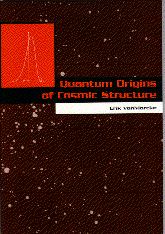

ABBREVIATED CONTENTS: see below
ABOUT THE BOOK
"You can in principle simulate points on a computer under the force of gravity', says cosmologist Joseph Silk (in Origins, Lightman & Brawer 1992), "but galaxy formation is something quite different. There you have many other complex things going on, including star formation, and we just have the vaguest glimmerings of a successful theory". Embryonic inflation, introduced in this book, stakes a claim to be such a theory.
Based on a hypothesis about the quantum-physical and embryo-like nature of inflation -- the first instant of the Big Bang -- the theory traces the origin of the precursor nebulae of a broad hierarchy of astronomical objects to sequences of single energy quanta produced by a (random) process of proliferation of inflation-era particles, and provides initial conditions for a specific scenario of how cosmic structure forms and evolves.
The theory has a small number of observationally-accessible parameters and generates many testable predictions, in particular about the formation, evolution, internal structure and composition of collapsed objects like stars and planets. Implying a robust alternative to the dual paradigm of spatially-uniform light-element primordial nucleosynthesis and stellar recycling of matter as the sole mechanism of heavy-element production, it integrates astrophysical and planetary sciences -- their tenets fittingly revised -- with cosmology in a coherent evolutionary framework.
ABOUT THE AUTHOR
Erik VanMarcke is a professor in the School of Engineering and Applied Science at Princeton University. He was on the faculty of the Massachusetts Institute of Technology until 1985 since receiving his Ph.D. there in 1970. He held visiting appointments at Harvard University and the University of Leuven in his native Belgium, and was the Shimizu Corporation Visiting Professor at Stanford University. The author of Random Fields: Analysis and Synthesis, published by the M.I.T. Press in 1983, he has since extended his studies of complex random variation to modeling the early-universe density fluctuations and their consequences, with results presented in Quantum Origins of Cosmic Structure. For more, see CV.
- Uncertainty of properties of single energy quanta
- Stochastic model of inflation by particle proliferation
- The complex energy distribution at the end of inflation
- Consequences for the cosmic distribution of matter
- Temperature and entropy: space-time variation
- Origin and distribution of chemical elements
- Structure formation: the role of primeval plasma
- Estimation of embryonic-inflation-model parameters
- Origin and evolution of galaxies and quasars
- Origin an evolution of solar systems
- Theory's consequences for particle physics
- Complexity, causality and cosmic genetics
Additional contents: Introduction; Overview of findings; Postscript: General assessment of the theory; Appendices: A. Hubble's law and redshifts, B. Homogeneous expanding-universe models, C. Inflationary universe scenarios; References; Index; List of symbols; 47 Figures; 2 Tables.
PRINCETON UNIVERSITY NEWS RELEASE of DEC. 17, 1997